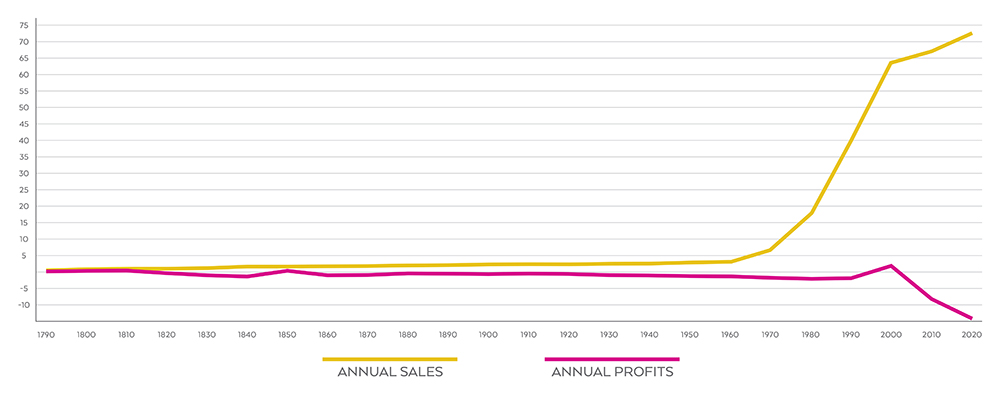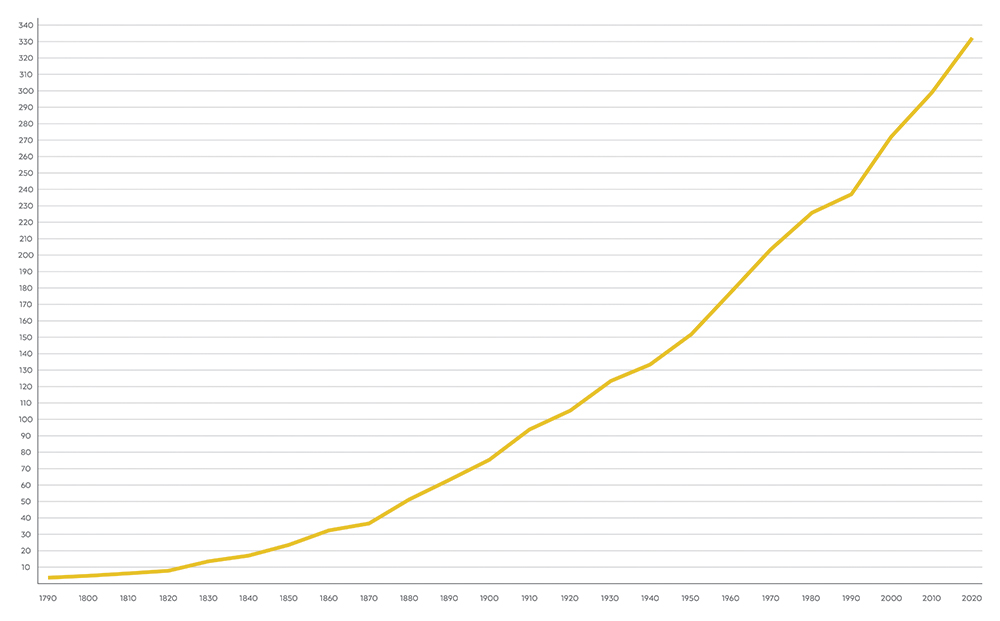WHO KILLED THE POST OFFICE?
In 2006, Congress passed the Postal Accountability and Enhancement Act. Instituting a number of changes, the most interesting one was the mandate that the United States Postal Service must fund in advance the health and retirement benefits of all postal employees for 50 years. Numerous articles have been published over the past 17 years citing this one requirement as the downfall of the Post Office. The argument is that Congress took an organization with $6 billion in profits and turned it into a massive failure with $160 billion of debt. According to the data, is that what really happened?
The United States Post Office Department was officially created in 1792 by the Postal Service Act. It utilized the system of roads and schedules that had been developed and overseen by Benjamin Franklin as the postmaster general of the colonies. The system was based on the Royal Postal Service of England, which in the 18th century was responsible for delivering mail to 10 million people in an area of 130,000 square kilometers. In contrast, the new United States had to deliver mail to 4 million people across 1.4 million square kilometers, ten times the area of England. That statistic is important to remember, because it would play a role in the evolution of the Post Office for the rest of the country's history.
In its first year, the Post Office grossed $67,443 with a net profit of $12,913. It would continue to generate a profit for the next 28 years. In 1820, it posted its first loss, $50,000. Over the next 32 years, the Post Office only generated a profit for 12 years, but overall netted $400,000. In 1852, the Post Office lost almost $2 million on $5 million of revenue. Over the next 118 years, the Post Office would only register a profit for 13 years, ultimately losing over $18 billion.
USPS ANNUAL REVENUE AND EARNINGS IN BILLIONS OF DOLLARS

Surprisingly, these losses had nothing to do with the radical reorganization of the Post Office that occurred in 1970. It was a national postal worker strike and discussions of unfair management and wages that led to the redefinition of the Post Office. After being a department of the federal government, and a cabinet position for much of that time, the Postal Reorganization Act of 1970 transformed the Post Office into the United States Postal Service (USPS), a government-owned corporation that is expected to be self-sufficient rather than subsidized by taxes. Why Congress believed this was a realistic expectation after over 100 years of losses is unclear, but so are a lot of decisions by the United States Congress.
After the formation of the USPS, the organization continued to lose millions of dollars every year until 1979. That year, the USPS posted its first multi-million-dollar profit of almost $300 million. Until 2006, the new organization posted a profit for 21 of the 35 years, netting over $25 billion for that period. This is the period where most analysts focus when describing the USPS as a wildly successful organization which was ruined by the 2006 legislation. Since 2006, the USPS has not had a profitable year, and has lost $98 billion in the past 17 years. In its 233-year history, the USPS has only posted a profit in 75 of those years for an overall loss of $91 billion.
In the early decades of the United States, the Post Office accounted for 75% of all federal employees. By the end of the 19th century, its representation had dropped to 50%. Throughout the 20th century, Post Office employees comprised 20-30% of the federal workforce. In 2023, postal workers were only 17% of all federal workers. To be fair, postal employees ceased to be federal employees in 1971, but many people use these figures to emphasize how the federal government has progressively understaffed and disregarded the USPS, leading to its recent demise. While its true that the Post Office has gone from the dominant portion of the federal government to an almost irrelevant offshoot, that dynamic has been a result of the expansion of other federal departments over time, not a proportional reduction of postal workers. In 1810, when the Post Office was 76% of the federal government, there was one postal worker for every 2200 Americans. In 2020, one postal worker existed for every 700 citizens. So, according to staff ratios, the USPS has improved its ability to serve the country's population. The problem isn't understaffing.
UNITED STATES POPULATION IN MILLIONS OF PEOPLE

Two factors which led to the Post Office becoming unprofitable were the expansion of the population and the expansion of land area. The Post Office was originally designed as a British copy of a system which had to service half the population in ten times the area. By the 1850s, when the Post Office began bleeding money, the United States passed Britain's population by increasing tenfold from 1792, and its land area had increased fourfold to include almost the entire current continental territory. What's more, prior to 1863, postal rates were determined by distance; the further a letter or package had to be delivered, the more expensive it was. After 1863, the first class stamp was created which was good for delivering any letter anywhere in the recently enlarged United States for two cents. The rapid increase of population and land area combined with the new ridiculously low postage rates created a situation which was nearly impossible to sustain profitability. But that also wasn't an issue since the Post Office existed as a necessary function of the government and was propped up by taxes.
UNITED STATES LAND AREA IN MILLIONS OF ACRES

That changed in 1970. Along with creating the United States Postal Service as a company rather than a department, the USPS was granted the power to set postal rates. During the 107 years between 1863 and 1970, the first class stamp increased from two cents to six cents. In the 35 years between 1970 and 2006, when the USPS enjoyed its highest profits, the first class stamp increased to 39 cents, a 550% increase in one third of the time. But raw postage isn't enough to drive profits. The main investment the USPS made during its golden years was in technology. Automation, computers, and lean practices made the organization more accurate and efficient, which in turn made it more profitable. During that same time the U.S. population increased by almost 100 million, meaning more mail was needed for more people. The USPS delivered its highest volume in 2006, over 213 billion pieces of mail. Charged with becoming profitable, the USPS had figured out a way to do it ... temporarily.
It seemed like the perfect solution. The government had freed itself from directly funding one giant department. The USPS had discovered profitability as an independent enterprise. The postal employees were receiving better wages and benefits. And the country was experiencing better service and increased reliability. Then came the Postal Accountability and Enhancement Act of 2006. Among many things, it notably restricted the increase of postal rates to not outpace inflation, restructured the regulatory and financial mechanisms of the USPS, and required the USPS to create a fund and contribute annually to the future medical and retirement benefits of its employees. All of these changes were aimed at taking advantage of the massive profits of the USPS, which everyone assumed would continue, to help alleviate the burden of lesser performing federal departments and ultimately reduce the national debt. On paper, it seemed to make sense. But everything began to fall apart immediately after that legislation.
So did Congress ruin the Post Office? The burden of prefunding retirement benefits was definitely immense, so immense, in fact, that the USPS only made the payments for about two years. In 2009, it stopped making those payments due to a lack of funds. So while the required payments appeared on USPS annual statements as an expense, it wasn't a real expense because it wasn't being paid. The USPS couldn't pay it because it began losing money again in 2007. Between 2007 and 2009, the USPS lost almost $12 billion. At first, it was definitely due to the new retirement benefits payments, but once the USPS stopped making those payments, something else has to be identified as the cause.
In 2006, first class mail, marketing mail, and periodicals accounted for 90% of USPS revenue to a total of $65 billion. By 2023, the traditional mail that comprised 90% in 2006 made up only 52% of total revenue at $40 billion. Those diminishing revenues in traditional mail services over the past 17 years add up to a potential $300 billion in losses. That more than accounts for the $98 billion which was actually lost during that time.
So what caused such a steep drop in traditional mail? Ironically, it seems the savior of the USPS in the decades of profitability was its destruction after 2006: technology. In 2006, the average mobile user in the United States sent 60 text messages every month. In 2007, that more than doubled, and it more than doubled the following year as well. By 2011, 600 texts were being sent on average by everyone every month. The communication culture of the U.S. changed radically within a few years, and suddenly a lot of traditional mail was not only unnecessary, it was irrelevant. Communication became electronic, and the USPS had nothing to offer. Between 2006 and 2011, the volume of mail dropped 21%, from an all-time high of 213 billion pieces to 168 billion pieces. By 2023, that had fallen to 116 billion pieces, almost half the volume of 2006.
The United States Postal Service absolutely changed after 2006, but it wasn't the Postal Accountability and Enhancement Act that caused its decline. It was an uncanny correlation that the act was passed in 2006. The actual cause was a rapid change in communication in the United States. Interestingly, one aspect of Postal Service has seen a dramatic jump over the past 17 years. In 2006, shipping packages was only 3% of total revenue at $2 billion. in 2023, shipping had increased to $32 billion, 40% of total revenue. Accordingly, the Postmaster General recently announced that the USPS is focusing on growing its package shipping to become profitable again. Time will tell if that strategy yields the desired results.
The United States now has a population of 330 million that covers 6 million square kilometers. It is the third largest country on the planet by both population and land area, creating a unique challenge for any system of mail delivery. United States Postal Service delivers almost 50% of all the mail in the world. Our history seems to indicate that is not an profitable endeavor, but despite its financial losses, the Post Office is far from dead. The 35 years when it was profitable appears now to be an outlier in a time that has since vanished. The Post Office is one of the few federal departments that is actually specified in the United States Constitution. Indeed, there isn't a single country that doesn't have some form of postal service. The United States Postal Service may be the quintessential example of a company that is too big to fail.
SOURCES
- "Congress Is Sabotaging Your Post Office" from Washington Monthly
- "John Oliver on Why the USPS is on the Brink of Collapse" from Boston.com
- "The Postal Service Needs a Bailout. Congress is Partly to Blame" from The Washington Post
- "The Economic History of Britain since 1700" from Berkley University of California
- "England Summary" from Britannica
- "Population of States and Counties of the United States: 1790-1990" from U.S. Census Bureau
- "Federal Government Employment: 1901 to 2002" from the U.S. Census Bureau
- "Postal History Since 1789" from the United States Postal Service
- "An American History" from the United States Postal Service
- "Number of Postal Employees Since 1926" from the United States Postal Service
- "A Closer Look at Postal Labor Costs" from the United States Postal Service
- "Post Office Pensions: Some Key Myths And Facts" from Forbes
- "A Decade of Facts and Figures" from the United States Postal Service
- "Average Number of Text Messages Sent per User per Month in the United States from 2005 to 2011" from Statista
- "USPS Plans to Cut $5B in Costs, Grow Revenue to Avoid Running out of Cash in Coming Years" from Federal News Network
- "List of National Postal Services" from Wikipedia
- Revenue and earnings data from USPS annual reports







